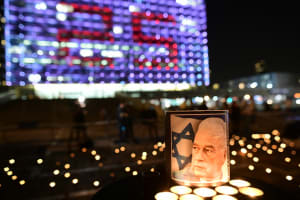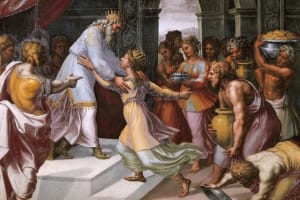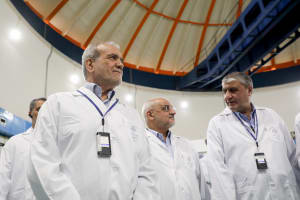Exploring Sebastia: A forgotten biblical capital in the heart of Samaria
The ancient capital where Israel’s kings ruled — and John the Baptist was imprisoned.

Levy Simon from Discover Israel Tours shows ALL ISRAEL NEWS correspondent, Oriel Moran, around a site in the middle of “Area A” in Judea and Samaria (internationally known as the West Bank), under the control of the Palestinian Authority. Although considered dangerous for Israeli visitors, organized tours can be arranged in coordination with the army, to explore some of the land’s best kept secrets.
“We are in the heartbeat of [Samaria] in a place called Sebastia,” Simon announces. ”Its strategic importance dominates anywhere else in this region.” Though Sebastia may not be a typical tourist hotspot, it is a key site nonetheless. Unravelling multiple eras of history, Simon explains why Sebastia is such an important spot that appears several times in the Bible.
From the top of the outer security walls, Simon delves into the Second Temple era: “Herod is given this city by [Roman Emperor] Augustus in the year 30 BCE. He's given Sebastia to turn [Samaria] into an example of a Roman city,” he begins, adding that though once aligned with the Jews, it didn't turn out very well for Herod.
Known for his building enterprises, Herod opted for classic Roman architecture including a forum as a central gathering space, and “cardos” or artery roads running from north to south. “We're going to see bathhouses, we'll see temples here, we can see a hippodrome, we can see an amphitheater, and also the theaters, really a bustling Roman life,” says Simon. “He starts changing [Samaria] from a Jewish Hellenistic influenced Hasmonean country into a Roman country.”
From the remains of the Roman forum, Simon explained how the Crusaders later came and built a classic basilica style church at the site with columns and an apse. “You can see the magnitude and importance of the place during the Crusader period,” Simon points out, showing how the Roman columns were repurposed by the Crusaders.
While Herod built a classic Roman theater with a stage that might have hosted gladiators, remains from the Hellenistic period some 300 years earlier can still be seen. “There’s a tower and storage houses which were built in those places,” says Simon, showing how it once would have looked with the original bricks.
Going back even further to the Middle Iron Age, Simon takes us into another biblical era: the time of the kings some 2,800 years ago. “We see King Omri and King Ahab making this their capital, a turning point in the belief of one God,” he explains. “If we look around at this glorious 360 degree view you can see why this was turned into the capital of Israel.”
Standing inside King Omri's capital, Simon takes us on a journey back to the book of 1 Kings in the Bible. Pointing out the well-constructed square stones, a sign of great wealth and importance, Simon explains, “Thousands of ivory pieces were found inside of his palace that I'm standing in right now. Gold chariots were here, mentioned outside of biblical sources… There are more mentions, archeologically, about the house of Omri, after which then comes the house of Ahab, with archaeology around our region, with the Assyrian kings… than there are mentions of the king's house of David,” he says.
There are also the remains of a church from the Byzantine period, which was later reconstructed by the Crusaders. “You can see classic crusader architecture here in different places,” explained Simon. “Looking at the entrance over here we can see red granite. The only red granite quarries we have are over 500 kilometers [about 311 miles] south of us all the way in Egypt. This was a status symbol to show the importance of this place,” he added.
Sebastia is also famous on account of one of Herod’s unexpected enemies: John the Baptist. It is the location of the prison where John is thought to have been held before being beheaded. John had announced Jesus as the Messiah, and the Gospel of Matthew explains that Herod was intrigued by the prophet, but threw him in jail after John prophetically called him out for adultery. “Things might not always turn out or end up the way that we want to, but the mission of God through us is always accomplished when we ask for it to be accomplished through us,” reflected Moran.
Sebastia is high on a hilltop overlooking Nablus (Shechem), one of the oldest biblical cities mentioned way back in the book of Genesis. The scenery is described in the stories of the patriarchs through to the time the Israelites come back to the land after the exodus from Egypt.
In the Law, God lays out blessings and curses, telling Israel to stand on two mountains and declare the blessings and curses that come with following the Law or abandoning it. Mount Gerizim was designated as the mountain of blessings, and Ebal the mountain from which they pronounced the curses.
Seeing the outcome in history of abandoning God’s ways, Simon warns, “Sebastia is on the side of the cursed mountain. We can see King Omri and King Ahab, where they go off the path of one God and they turn into disaster… The curses become true.”
“The Bible is a book that is respected by most of the people in the world,” he concluded. “It's a book of direction and holiness. It's such a privilege to be able to stand in the places where these stories happen.”

Is All Israel News’ faith-based reporting important to you? Be part of it—help us continue by becoming a $5/month supporting partner.

Jo Elizabeth has a great interest in politics and cultural developments, studying Social Policy for her first degree and gaining a Masters in Jewish Philosophy from Haifa University, but she loves to write about the Bible and its primary subject, the God of Israel. As a writer, Jo spends her time between the UK and Jerusalem, Israel.
You might also like to read this:

















